I'm not certain, but I think the error you are seeing may come from the dataset you are using. You didn't provide data, so it's hard to know for sure.
I think the general approach to the model you have is OK, but missing some features. For one thing, your Lorentzian's will have a value of zero far from their centroids, whereas your Mossbauer data is around 25000.
More importantly, you definitely need to give somewhat realistic initial values for the parameters, and those values should not at the boundary you set. If it is not obvious, setting all values to zero will give a model curve that looks nothing like your data. I cannot stress this strongly enough: you absolutely must provide initial values that are reasonably close such that they can be changed by a small amount and give a noticeable change in the result of "data-model".
Since you didn't provide data, I made some up that looks sort of close ;), and used the builtin lmfit models, something like this, which might be a good start:
#!/usr/bin/env python
import matplotlib.pyplot as plt
import numpy as np
from lmfit.models import ConstantModel, LorentzianModel
from lmfit.lineshapes import lorentzian
npts = 2001
velo = np.linspace(0, 1000.0, npts)
signal = (26900 + np.random.normal(size=npts, scale=100)
- 80000. * lorentzian(velo, center=240, sigma=6)
- 79000. * lorentzian(velo, center=790, sigma=7) )
# model = constant + 2 Lorentzians
model = ConstantModel() + LorentzianModel(prefix='p1_') + LorentzianModel(prefix='p2_')
# guess initial values
params = model.make_params(c=25000,
p1_center=250, p1_sigma=10, p1_amplitude=-10000,
p2_center=750, p2_sigma=10, p2_amplitude=-10000)
params['p1_amplitude'].max = 0 # enforce p1_amplitude < 0
params['p2_amplitude'].max = 0
out = model.fit(signal, params, x=velo)
print(out.fit_report())
plt.plot(velo, signal, 'o', label='data')
plt.plot(velo, out.best_fit, label='fit')
plt.legend()
plt.show()
This will give a report of
[[Model]]
((Model(constant) + Model(lorentzian, prefix='p1_')) + Model(lorentzian, prefix='p2_'))
[[Fit Statistics]]
# fitting method = leastsq
# function evals = 109
# data points = 2001
# variables = 7
chi-square = 19912468.9
reduced chi-square = 9986.19301
Akaike info crit = 18434.1141
Bayesian info crit = 18473.3239
R-squared = 0.96651410
[[Variables]]
c: 26897.4478 +/- 2.43041838 (0.01%) (init = 25000)
p1_amplitude: -80171.1149 +/- 638.944430 (0.80%) (init = -10000)
p1_center: 239.908167 +/- 0.04587653 (0.02%) (init = 250)
p1_sigma: 5.99624015 +/- 0.06621609 (1.10%) (init = 10)
p2_amplitude: -78808.0930 +/- 694.381394 (0.88%) (init = -10000)
p2_center: 789.912879 +/- 0.05883249 (0.01%) (init = 750)
p2_sigma: 6.99732305 +/- 0.08516581 (1.22%) (init = 10)
p1_fwhm: 11.9924803 +/- 0.13243219 (1.10%) == '2.0000000*p1_sigma'
p1_height: -4255.87684 +/- 32.5617804 (0.77%) == '0.3183099*p1_amplitude/max(1e-15, p1_sigma)'
p2_fwhm: 13.9946461 +/- 0.17033163 (1.22%) == '2.0000000*p2_sigma'
p2_height: -3584.99901 +/- 30.1429487 (0.84%) == '0.3183099*p2_amplitude/max(1e-15, p2_sigma)'
[[Correlations]] (unreported correlations are < 0.100)
C(p2_amplitude, p2_sigma) = -0.7230
C(p1_amplitude, p1_sigma) = -0.7211
C(c, p2_amplitude) = -0.2989
C(c, p1_amplitude) = -0.2800
C(c, p2_sigma) = +0.2133
C(c, p1_sigma) = +0.1998
and a plot of

